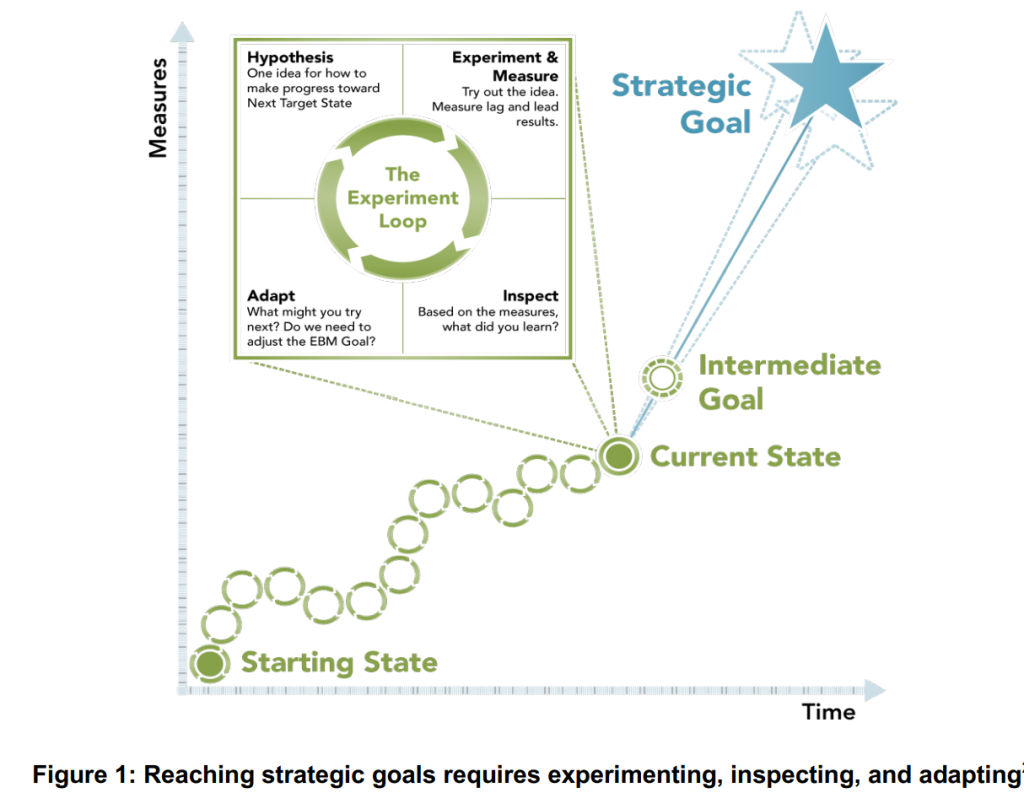Purpose of the EBM Guide
Evidence-Based Management (EBM) is an empirical approach that helps organizations to continuously improve customer outcomes, organizational capabilities, and business results under conditions of uncertainty. It provides a framework for organizations to improve their ability to deliver value in an uncertain world, seeking a path toward strategic goals. Using intentional experimentation and evidence (measures), EBM enables organizations to systematically improve their performance over time and refine their goals based on better information.
By measuring current conditions, setting performance goals, forming small experiments for improvement that can be run quickly, measuring the effect of the experiment, and inspecting and adapting goals and next steps, EBM helps organizations to take into account the best available evidence to help them make decisions on ways to improve.
This Guide defines EBM, its concepts, and its application.
EBM Helps Organizations Seek toward Their Goals in a Complex World Using Empiricism
Complex problems defy easy solutions, but instead require organizations seek toward their goals in a series of small steps, inspecting the results of each step, and adapting their next actions based on feedback (see Figure 1).1
This model has several key elements:
A Strategic Goal, which is something important that the organization would like to achieve.
This goal is so big and far away, with many uncertainties along the journey that the organization must use empiricism. Because the Strategic Goal is aspirational and the path to it is uncertain, the organization needs a series of practical targets, like Intermediate Goals, achievements of which will indicate that the organization is on the path to its Strategic Goal. The path to the Intermediate Goal is often still somewhat uncertain, but not completely unknown.
Immediate Tactical Goals, critical near-term objectives toward which a team or group of teams will work help toward Intermediate Goals.
A Starting State, which is where the organization is relative to the Strategic Goal when it starts its journey.
A Current State, which is where the organization is relative to the Strategic Goal at the present time.
In order to progress toward the Strategic Goal, organizations run experiments which involve forming hypotheses that are intended to advance the organization toward their current Intermediate Goal. As they run these experiments and gather results, they use the evidence they obtain to evaluate their goals and determine their next steps to advance toward these goals.

Setting Goals
When setting goals, organizations must define specific measures that will indicate that the goal is achieved. Goals, measures, and experiments should be made transparent in order to encourage organizational alignment.
Consider the case of the response to an infectious disease:
- The Strategic Goal is to eradicate the effects of the disease, as measured by the number of people who fall ill and suffer significant illness. Measurement is important; in this example, the goal is focused on the effects of the disease, and not on the means for achieving the desired impact. For example, the goal is not to vaccinate a certain percentage of the population against the disease; that may be an activity necessary to achieving the Strategic Goal, but it is not the Strategic Goal.
- An example of an Intermediate Goal is the successful completion of a trial of a vaccine against the disease. This is still ambitious and measurable, and achieving it may require the completion of many different activities, but it is seen as a necessary step on the path to achieving the Strategic Goal.
- Examples of immediate tactical goals may include activities like isolating symptoms, evaluating a therapy, sequencing the DNA of a virus or bacterium, and so forth.
The Strategic Goal is usually focused on achieving a highly desirable but unrealized outcome for a specific group of people that results in improved happiness, safety, security, or well-being of the recipients of some product or service. In EBM, we refer to this as Unrealized Value, which is the satisfaction gap between a beneficiary’s desired outcome and their current experience.
Unrealized Value is described in greater detail below, in the Key Value Areas section.
Understanding What Is Valuable
Organizations measure many different kinds of things. Broadly speaking, measures fall into three categories:
- Activities. These are things that people in the organization do, such as perform work, go to meetings, have discussions, write code, create reports, attend conferences, and so forth.
- Outputs. These are things that the organization produces, such as product releases (including features), reports, defect reports, product reviews, and so on.
- Outcomes. These are desirable things that a customer or user of a product experiences. They represent some new or improved capability that the customer or user was not able to achieve before. Examples include being able to travel to a destination faster than before, or being able to earn or save more money than before. Outcomes can also be negative, as in the case where the value a customer or user experiences declines from previous experiences, for example when a service they previously relied upon is no longer available.
The problem most organizations face, which is often reflected in the things they measure, is that measuring activities and outputs is easy, while measuring outcomes is difficult. Organizations may gather a lot of data with insufficient information about their ability to deliver value. However, delivering valuable outcomes to customers is essential if organizations are to reach their goals.
For example, working more hours (activities) and delivering more features (outputs) does not necessarily lead to improved customer experiences (outcomes).
